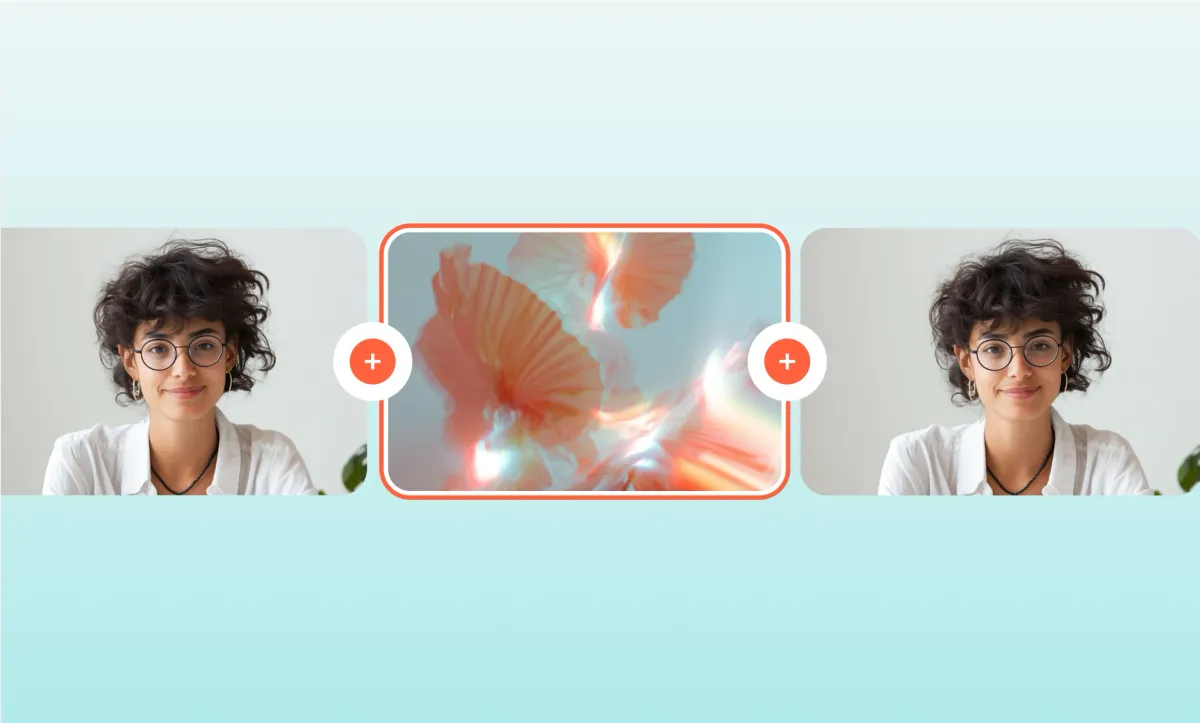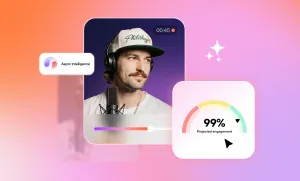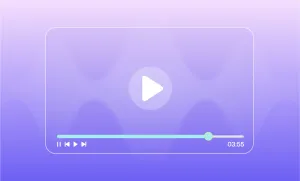Lights, camera... wait, where's the action? If you've ever watched a video that felt flat or struggled to keep your audience hooked, you might be missing the secret sauce of professional filmmaking: B-roll. Top creators swear by it, editors clamor for it, and viewers? They're captivated by it, even if they don't know it exists. But what is B-roll footage, and why exactly do you need it? We’re here to explain it all!
What is B-roll footage?
Picture your favorite documentary. What scenes come to mind? While you might recall an expert speaking to the camera, it's the breathtaking landscapes, revealing close-ups, and dynamic action shots that truly bring the story to life. These essential elements are known as B-roll footage, and they're the key to transforming good videos into great ones.
On the other hand, imagine if the entire documentary only showed people sitting on chairs and talking. Viewers would likely tune out rather quickly. But B-roll is what keeps videos from falling flat, as it's a type of supplemental footage that's dynamic in nature and balances out any scenes that may be more static.
But just as there is B-roll, which are those extra shots that add something more dynamic to your videos, the main footage, where the narrator or main subject is speaking directly to the camera, is often referred to as the "A-roll". Both are crucial, and here's why.
A-roll vs B-roll
Back when movies were edited on physical film reels, editors used two rolls of film. The primary footage was on the "A" reel (A-roll), and the supplementary footage was on the "B" reel (B-roll.) These B-roll clips were used to add visual interest and to cover up cuts or edits in the A-roll. They provided a way to maintain visual continuity, keep the story flowing smoothly, and make the overall viewing experience more engaging.
Moreover, in the early days, these reels were physically spliced together, and having a B-roll was incredibly handy for hiding those splices and transitions. Imagine how choppy a film would look without those secret visual bridges.
Today, even in a filmmaking industry that's quite digital, the concept remains the same. B-roll is still essential for creating compelling visual narratives and is often used when two A-roll shots don’t quite click together in the editing process. Whether it’s a feature film, news segment, or a wedding video, B-roll helps to tell the story better, providing context and keeping the audience engaged.
Why is B-roll important
1) Makes your film visually more beautiful
As we’ve already mentioned, it's unlikely anybody likes to sit and watch a 2-hour documentary filled with just people talking to the camera. If you want to turn your video into a visually exciting experience, you absolutely must have B-roll footage in it. Try shooting scenic landscapes, catching some scenes with action, or just giving a close-up of an important object to make your viewers more invested in your story. By weaving a B-roll into the main narrative, you can create a richer, more immersive experience that holds viewers' attention and keeps them visually stimulated.
2) Smooth video transitions
Video transitions can make or break your video content. Let's take a look at a classic example. A lot of filmmakers still can’t get over that one perfect match cut Kubrick made back in 2001, when the spinning bone thrown by an early hominid perfectly transitioned to an orbiting space satellite in “A Space Odyssey.” Since this cut, filmmaking hasn’t been the same, and a lot of videographers and directors have tried to come up with an equally perfect match cut concept.
Now, here’s when we’re about to break it down to you: although we’re sure you can make the perfect match cut, it’s always a good idea to have some B-rolls up your sleeve in case those two scenes don’t really cut together as good as you envisioned them. Never stop trying to get those fun and exciting cuts, but also always shoot B-rolls when on set, as these can be your lifesavers when your storyboard editing suggestions don’t make sense in the actual editing room.
3) Adds context and depth
B-roll footage is crucial for providing context and depth to the main story. For example, in a documentary about climate change, shots of melting glaciers, deforested areas, or polluted rivers offer powerful visual evidence that complements the script and the voiceovers of your film. These complementing clips help to illustrate and emphasize the points being made by the narrator or interviewees. It is the easiest way to add layers of context and make sure that the audience fully understands and connects with the story on a deeper level. Overall, when used correctly, the B-roll footage will make your message more impactful.
How to shoot B-roll?
Whether you're using a professional camera or a smartphone, capturing a high-quality B-roll is achievable with the right techniques. Here are some tips for shooting a B-roll on both iPhones and Android devices.
How to shoot B-roll on your phone
Don’t know how to do B-roll on an iPhone? Or maybe you need to know how to shoot a B-roll on Android? Whatever your mobile device is, with the right tools and tips, shooting a B-roll on your phone will be quick and easy! Here’s how:
- – Stabilize Your Shot: Use a tripod or a gimbal to keep your footage steady. This will make your B-roll look more polished and professional.
- – Use the Right Settings: Switch to 4K resolution for the best quality. Adjust the frame rate based on your needs—24fps for a cinematic look or 60fps for smooth motion.
- – Focus and Exposure: Tap on the screen to lock focus and adjust exposure. This helps prevent the camera from constantly refocusing and adjusting brightness.
- – Lighting: Natural light works well, but if you're indoors, use lamps or LED lights to brighten the scene.
- – Variety of Shots: Capture a mix of wide, medium, and close-up shots. This variety will give you more options during editing.
- – Movement: Add some movement to your shots. You can pan slowly from left to right or use a slider for smooth motion.
- – Angles: Experiment with different angles. Shoot from high above or low down to create interesting perspectives.
- – Editing: Use editing apps to trim and arrange your B-roll clips, ensuring they complement your A-roll footage.
If you're using your smartphone, the best part is that you can use tools like Podcastle to film the highest resolution footage through our app, store the footage on our cloud, and edit it later on your laptop with a handful of AI features, including video enhancing tools to really bring your 4k captures to life:
Tips for shooting B-roll footage
Step 1: Planning your B-roll
Before you start shooting, it's essential to plan your B-roll to capture the most relevant and useful footage. You can do so by:
- Identifying key moments: Determine which parts of your story or main footage would benefit from supplementary visuals. This could include significant events, transitions, or details that need emphasizing.
- Creating a shot list: A shot list helps organize your shooting process. It ensures you capture all necessary B-roll footage, avoiding last-minute scrambles or missing shots during editing.
- Scouting locations: Visit potential shooting locations beforehand to understand the environment and lighting conditions. This helps you plan your shots and anticipate any challenges.
Step 2: Shooting B-roll
This stage is where technical skill meets creativity, as your goal is to transform everyday scenes into compelling visuals that enhance your main narrative. To do so, there are several key techniques to keep in mind for the results:
1) Consider lighting and composition
Good lighting is crucial for a high-quality B-roll. Natural light is often best, but when shooting indoors, use additional lighting to avoid shadows and ensure clear visuals. Pay attention to composition by following the rule of thirds, leading lines, and framing techniques to create visually appealing shots.
2) Use a variety of angles and shots
Capture B-roll from different angles and perspectives to add variety. This can include wide shots, close-ups, and unique angles that provide a fresh view of the subject.
3) Capture natural sound
While B-roll is primarily visual, and in some cases you might include B-roll footage without its original sound, capturing ambient sounds can enhance the realism and immersion of your video if it calls for it. This could include background noises, nature sounds, or the hustle and bustle of a location.
Step 3: Selecting the best shots
Here's how to approach the selection process effectively:
- – Review your footage: After shooting, review all your b-roll footage and select the best clips. Look for shots that are well-composed, well-lit, and relevant to your narrative.
- – Match the tone and style: Ensure your B-roll footage matches the tone and style of your A-roll. Consistency in color grading, lighting, and visual style creates a cohesive final product.
- – Prioritize relevance: Choose B-roll clips that directly support or enhance the main footage. Avoid using shots that are visually appealing but irrelevant to the story.
Step 4: Editing B-roll footage
Editing is the final, yet one of the most important steps, in publishing top-tier B-roll footage. The way you edit together B-roll and A-roll footage should be seamless, enhancing the narrative without distracting the viewer. If you’re advanced in video editing, try using software like Adobe Premiere, but if you’re a beginner and need a simple yet powerful editing tool that will help you quickly enhance your footage, we suggest trying Podcastle. It will allow you to edit your video clips with AI and get beautiful cuts with your brand on it in no time:
Final thoughts
Knowing how to incorporate B-roll footage into your video content is one of many ways you can significantly enhance your storytelling skills and make your videos visually stunning from start to finish. Plus, with tools like Podcastle – which comes packed with dedicated AI video editing features to enhance video resolution and take the heavy editing load off your shoulders – you can take your projects from draft to publish in a fraction of the time.








